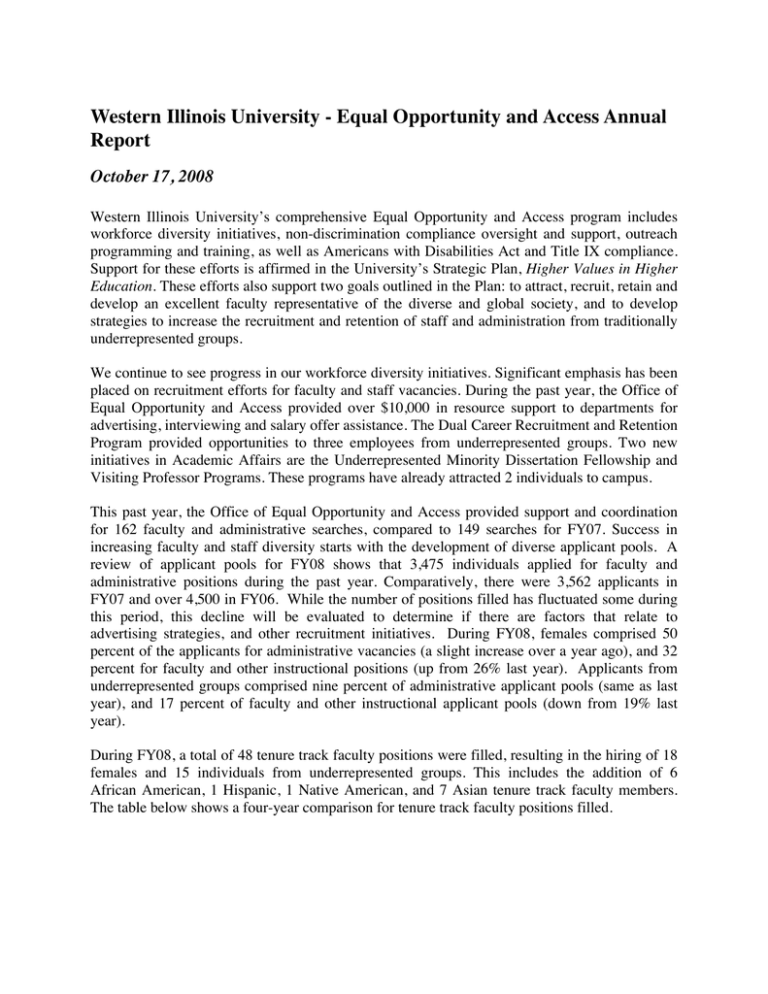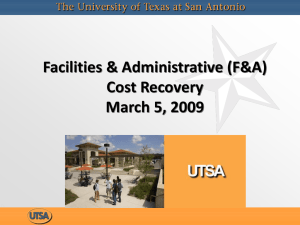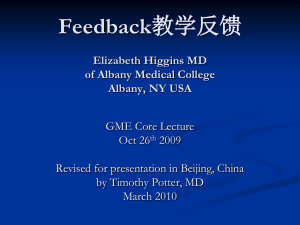Western Illinois University - Equal Opportunity and Access Annual Report
advertisement

Western Illinois University - Equal Opportunity and Access Annual Report October 17, 2008 Western Illinois University’s comprehensive Equal Opportunity and Access program includes workforce diversity initiatives, non-discrimination compliance oversight and support, outreach programming and training, as well as Americans with Disabilities Act and Title IX compliance. Support for these efforts is affirmed in the University’s Strategic Plan, Higher Values in Higher Education. These efforts also support two goals outlined in the Plan: to attract, recruit, retain and develop an excellent faculty representative of the diverse and global society, and to develop strategies to increase the recruitment and retention of staff and administration from traditionally underrepresented groups. We continue to see progress in our workforce diversity initiatives. Significant emphasis has been placed on recruitment efforts for faculty and staff vacancies. During the past year, the Office of Equal Opportunity and Access provided over $10,000 in resource support to departments for advertising, interviewing and salary offer assistance. The Dual Career Recruitment and Retention Program provided opportunities to three employees from underrepresented groups. Two new initiatives in Academic Affairs are the Underrepresented Minority Dissertation Fellowship and Visiting Professor Programs. These programs have already attracted 2 individuals to campus. This past year, the Office of Equal Opportunity and Access provided support and coordination for 162 faculty and administrative searches, compared to 149 searches for FY07. Success in increasing faculty and staff diversity starts with the development of diverse applicant pools. A review of applicant pools for FY08 shows that 3,475 individuals applied for faculty and administrative positions during the past year. Comparatively, there were 3,562 applicants in FY07 and over 4,500 in FY06. While the number of positions filled has fluctuated some during this period, this decline will be evaluated to determine if there are factors that relate to advertising strategies, and other recruitment initiatives. During FY08, females comprised 50 percent of the applicants for administrative vacancies (a slight increase over a year ago), and 32 percent for faculty and other instructional positions (up from 26% last year). Applicants from underrepresented groups comprised nine percent of administrative applicant pools (same as last year), and 17 percent of faculty and other instructional applicant pools (down from 19% last year). During FY08, a total of 48 tenure track faculty positions were filled, resulting in the hiring of 18 females and 15 individuals from underrepresented groups. This includes the addition of 6 African American, 1 Hispanic, 1 Native American, and 7 Asian tenure track faculty members. The table below shows a four-year comparison for tenure track faculty positions filled. Tenure Track Positions Filled FY05 # % Females 9 Individuals from 2 Underrepresented Groups Total FY06 # % FY07 # % FY08 # % 45 12 30 22 42 18 38 10 15 38 16 30 15 31 20 40 53 48 In addition to the tenure track searches, 47 other instructional positions were filled. This category includes temporary faculty, associate faculty, faculty assistants, and coaches. Of the new employees in this category, 26 (55%) are female and 6 (16%) are individuals from underrepresented groups. The table below shows a four-year comparison for other instructional positions filled. Other Instructional FY05 Positions Filled # % FY06 # % FY07 # % FY08 # % Females 25 Individuals from 2 Underrepresented Groups 68 45 57 13 65 26 55 5 14 18 5 25 6 13 Total 33 37 79* 47 *Initial FYE instructional hires (33) During the past year, 67 individuals were hired to fill administrative vacancies, including 33 females (49%) and 13 individuals from underrepresented groups (19%). Administrative Positions Filled Females Individuals from Underrepresented Groups FY05 # % 12 43 FY06 # % 33 72 FY07 # % 39 64 FY08 # % 33 49 5 26 9 13 19 Total 30 18 28 57 61 15 67 Hiring for the current fiscal year (FY09) is well underway and, to date, 30 faculty and academic vacancies have been advertised, including several academic administrative positions - the Dean of the College of Education and Human Services, and five department chair openings. Twentyfive administrative positions have filled since June 30, 2008. Individuals hired include 2 African Americans and 15 females. 2 Data also show that significant hiring activity occurred for civil service positions on campus during FY08. A total of 78 positions were filled, and individuals hired included 42 females and 5 individuals from underrepresented groups. The table below shows a four-year comparison. Civil Service Positions Filled Females Individuals from Underrepresented Groups FY05 # % 23 46 FY06 # % 42 63 FY07 # % 47 72 FY08 # % 42 54 7 10 9 5 Total 50 14 15 67 14 65 6 78 The University continues to utilize Trainee and Learner programs to enhance workforce diversity within civil service job groups. Trainee programs allow individuals an opportunity to receive “on-the-job” training. This procedural provision allows the University to hire individuals who possess career potential, but lack one or more of the minimum qualifications required to test for a particular classification. Once an individual meets the minimum qualifications he/she must take the Civil Service exam and pass with a score of 70 or better to continue employment in the position. Learner programs, like trainee programs, allow individuals the opportunity to learn on the job, and are used for classifications that do not have any minimum qualification requirements. Both trainee and learner programs can be utilized when the Civil Service exam has not provided a diverse pool of candidates for a particular job classification. Interest in Trainee and Learner programs continues to increase, with 357 active applicants in FY08 compared to 297 in FY07. During the past year there were 15 Trainee placements and 8 Learner placements active in various departments. Of these 23 individuals, 5 are AfricanAmerican and 1 is Asian/Pacific Islander. The tables below display Trainee and Learner placements by job classification for FY05, FY06, FY07 and FY08. It is important to note that individuals may be in a Trainee or Learner status for more than one year. Current Trainees Athletic Equip. Specialist Clerk Parking Service Agent II Office Support Staff Administrative Assistant Webmaster Night Supervisor of UU Image Processing Technician II Medical Records Tech. Electrical Engineer Press Technician I Total FY05 2 0 1 1 0 0 0 0 0 0 0 4 FY06 0 0 0 4 0 1 1 0 0 0 0 6 FY07 1 0 0 7 0 0 0 2 0 0 1 12 FY08 1 0 2 6 1 0 0 0 1 1 3 15 3 Current Learners Building Service Worker Mailing Equipment Ex/Op Police Officer Route Driver Stationary Fireman Helper Total FY05 8 1 1 0 0 10 FY06 5 1 0 1 0 7 FY07 0 0 4 2 1 7 FY08 6 0 0 0 2 8 The University’s compliance with Affirmative Action and Equal Opportunity includes providing a means for responding to and resolving complaints of harassment or discrimination. During the past year, 20 discrimination and/or harassment complaints were filed under the University’s Discrimination Complaint Procedures. Discrimination allegations by category include sex (4), race (5), national origin (2), sexual orientation (1), disability (5), religion (1), and retaliation (2). This compares to 24 complaints in FY07. In 5 of the cases filed in the past year, individuals were found in violation of the University’s non-discrimination policy and/or Anti-Harassment Policy. Individuals found in violation of University policy were disciplined in accordance with employment regulations and relevant collective bargaining agreements. During FY08, 3,377 individuals completed the university’s mandatory sexual harassment prevention training, a significant increase over last year (2,100 in FY07). This number includes 677 faculty, 1,335 civil service and administrative employees, and 1,365 graduate and undergraduate students. This increased participation is an important step in ensuring all employees understand their rights and responsibilities as defined in the University’s AntiHarassment Policy. Additional compliance activities involve a Gender Equity Oversight Committee including the Director of Intercollegiate Athletics, Senior Athletic Women’s Administrator, Vice President for Student Services, and the campus Title IX Coordinator. This group conducts a quarterly review of the University’s compliance with NCAA Commitment to Equity and Minority Opportunities plans as a part of the Intercollegiate Athletics Certification Program. A Gender Equity in Athletics report is also submitted to IBHE annually. The Office of Equal Opportunity and Access provides coordination for the University’s compliance with the Americans with Disabilities Act (ADA). ADA compliance includes administering procedures that allow individuals with disabilities to request and receive reasonable job accommodations. All employees are surveyed annually to collect information about medical conditions that may require an accommodation in the workplace. During FY08, workplace accommodations were provided to 104 individuals. Accommodations provided include the purchase of ergonomic or modified office furniture, employment of student assistants, modified work schedules, and the purchase of specialized technology for individuals with hearing and vision impairments. After implementing a reasonable accommodation, follow up is required to assess the effectiveness of the adjustments/purchases made and to determine if additional support is necessary. 4 The University Web Accessibility Committee continues to evaluate protocols and practices in web development to enhance accessibility. During the past year the Committee finalized the University Web Accessibility Policy, developed in compliance with the newly enacted Illinois Information Technology Accessibility Act. Purchasing and evaluation guidelines are being developed, along with plans for campus education and awareness activities. The university’s annual evaluation of the sufficiency of the Affirmative Action and Equal Opportunity program includes several factors and action steps. An availability analysis is conducted for all job groups to determine if underutilization of females or individuals from underrepresented groups exists. These data are shared with the President, Vice Presidents, Deans, and hiring administrators, along with a review of the hiring data from the previous year. Where underutilization is identified, recruitment strategies are reviewed and goals are set based on anticipated hiring opportunities in the coming year. The FY08 Utilization Analysis Report for Instructional Employees and the FY08 New Hire Utilization Analysis Report are attached. It is important to note that while the Office of Equal Opportunity and Access provides leadership and support for university efforts to diversify faculty and staff, success depends on a strong commitment from all members of the campus community. It is equally important to continue efforts to create a campus climate that is respectful, inclusive, and welcoming for all individuals, regardless of their sex, race, color, religion, national origin, sexual orientation, gender identity and gender expression, age, disability, marital status, and veteran status. In recognition of this reality, a University Diversity Council has been formed this fall, with representatives from the faculty, administration, civil service employees, and the student body. This Council will develop a strategic plan to achieve our diversity goals, and provide important feedback on the effectiveness of current efforts. Work thus far has included the development of an operating paper that will guide the Council’s work, and help to develop and implement new initiatives. The vision, mission and goals of the Council are included below. University Diversity Council Vision Statement The University Diversity Council (UDC) at Western Illinois University (WIU) recognizes that diversity is an indispensable element of our core values of Academic Excellence, Educational Opportunity, Personal Growth and Social Responsibility. The university is fundamentally committed to including and integrating individuals within our campus community from different groups regardless of their: gender, race, color, ethnicity, sexual orientation, gender identity and gender expression, religion, age, marital status, national origin, disability, veteran status, socioeconomic background, and/or intellectual outlook. Our commitment to diversity inevitably means actively supporting positive change and ultimately achieving transformation. Mission Statement The mission of the University Diversity Council is to identify and recommend deliberate efforts that attract and retain members of historically underrepresented individuals to WIU and to work to create a rich academic, intellectual, and cultural experience and environment for everyone by extending our focus beyond representation to genuine participation. 5 Goals The goals of the Western Illinois University’s Diversity Council are: (1) To serve in an advisory capacity to the Office of Equal Opportunity and Access (EOA). (2) To reinforce and advance efforts to sustain and promote campus diversity. As members of the diversity council, we consider this work essential to advancing the goals of the strategic plan – Higher Values in Higher Education – and supporting our mission to have a profound and positive impact on our changing world as we educate and prepare a diverse student population to thrive in and contribute to our global society. We also consider the promotion of campus diversity fundamentally necessary to effectuating positive change in the patterns of disadvantage and discrimination that are still so prevalent in the academy and in society. (3) To devise new diversity strategies and programs which support the values of Western Illinois University: academic excellence, educational opportunity, personal growth, and social responsibility, (4) To identify barriers to inclusion and diversity initiatives and to provide solutions to eliminate those barriers, and (5) To assist and support efforts to diversify WIU’s faculty, staff, and students and develop approaches to integrating diversity with respect to public service, teaching and research into WIU’s academic mission. The Office of Equal Opportunity and Access will work closely with this new Council to identify barriers to progress and best practices that will move us forward. Progress in meeting our goals and objectives is truly a campus wide effort. 6







